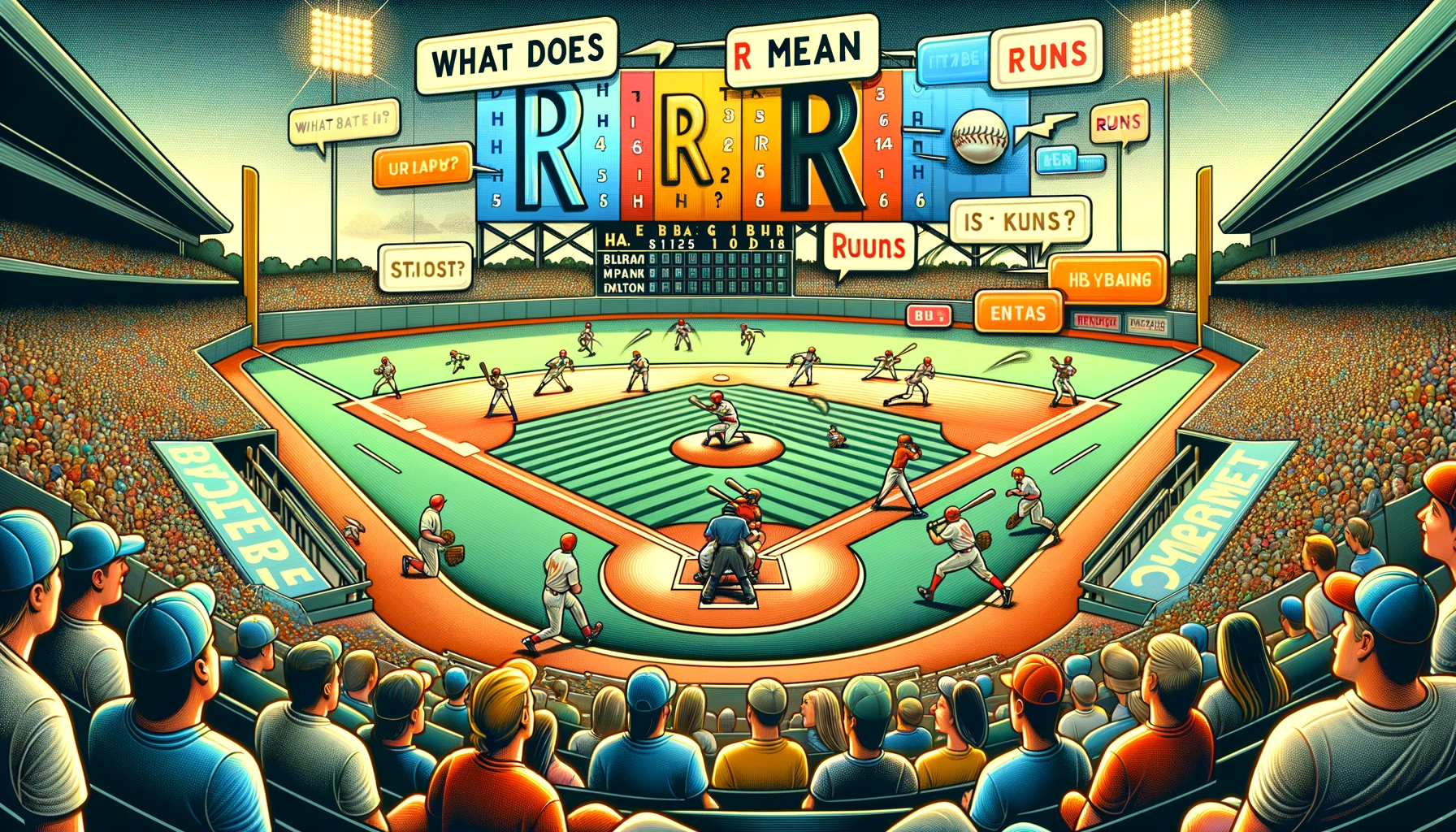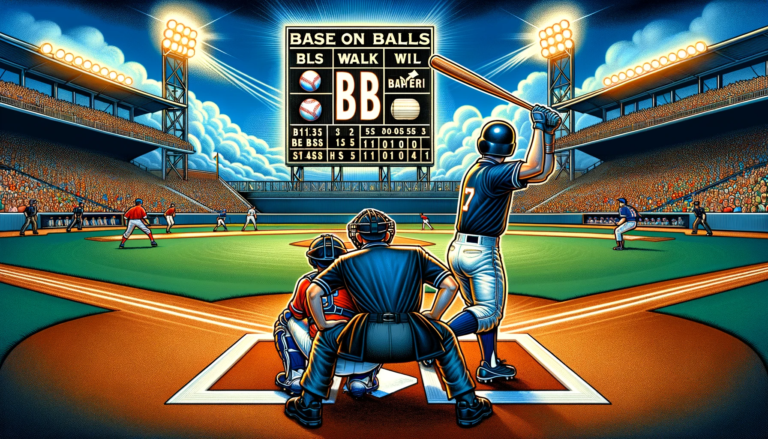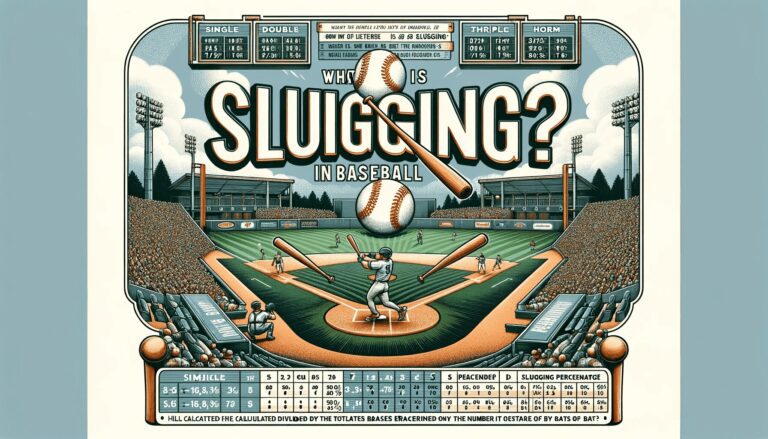What Does R Mean in Baseball? Baseball Stats & Abbreviation!
If you’re trying to understand baseball stats, you might have come across the abbreviation “R” and wondered what it stands for. “R” in baseball stands for “Runs.”
It’s a key statistic that measures the total number of times a player successfully makes it to home plate and scores.
In this article, we’ll explain what “R” means in baseball and how it relates to other common baseball statistics and abbreviations.
By the end, you’ll have a solid understanding of this crucial letter and be able to follow the game like a pro.
Key Takeaways
- ‘R’ on a baseball scoreboard represents the number of runs scored by a team, which is the primary way to determine the winner of a game.
- Runs have a direct impact on player stats and are a critical component in comparing players’ offensive contributions.
- A strong correlation exists between the number of runs a team scores and their chances of winning, making run production a key strategy.
- Batters, runners, and pitchers all play significant roles in the run-scoring process, with RBIs being a notable statistic for measuring individual contribution.
- Advanced metrics like Sabermetrics, OPS, and wOBA offer a deeper analysis of run production and can be used to predict future performance.
Understanding the Basics of Baseball Scoring

The Role of Runs in the Game
In the sport of baseball, runs are the lifeblood of the game, serving as the primary metric for determining the winner.
A run is scored when a player successfully rounds all the bases and crosses home plate. This can occur through a variety of means, such as a hit, a walk, or an error by the opposing team.
The accumulation of runs is critical, as the team with the most runs at the end of nine innings is declared the victor.
The process of scoring runs involves several stages:
- A batter becomes a runner by reaching base safely.
- The runner advances through subsequent batters’ actions or strategic plays.
- The runner ultimately reaches home plate to score a run.
Understanding the importance of runs is also essential when considering certain rules, such as the NCAA Baseball Run Rule.
This rule can expedite the conclusion of a game if a team leads by a significant margin, typically 10 or more runs after seven innings, although it is not universally applied, as seen in the College World Series. You may read also What Does 6 4 3 Mean in Baseball
How Runs are Scored
In baseball, a run is scored when a player advances around the bases and safely touches home plate.
The primary way a run is tallied is when a batter hits the ball and successfully rounds the bases without being put out.
This can occur through a variety of plays:
- A batter hits a home run, which allows them to circle all the bases and score without the risk of being out.
- A series of hits from the batting team enables runners to advance and eventually cross home plate.
- A defensive error that allows a runner to continue around the bases and reach home safely.
It’s important to note that not all advancements to home plate count as a run. For instance, if a player reaches home due to a fielding error or a fielder’s choice, it is not always scored as a hit. The intricacies of these situations are outlined in the official baseball scoring rules.
The Scoreboard Layout and Symbols
A baseball scoreboard is a visual display that provides a wealth of information at a glance. It typically features a grid-like layout, with each inning numbered from 1 to 9 or more if the game goes into extra innings.
The ‘R’ on the scoreboard stands for ‘Runs’, which is the total number of times players have successfully circled the bases and scored.
Other common symbols include:
- ‘H’ for hits, indicating the number of times batters have safely reached base.
- ‘E’ for errors, showing the number of defensive mistakes that have allowed runners to advance.
- ‘LOB’ for left on base, which counts the number of runners that did not score by the end of an inning.
Understanding these symbols is crucial for fans and players alike, as they provide immediate insight into the game’s progress and a team’s performance.
Read Also: What Does WAR Mean in Baseball
The Significance of ‘R’ in Baseball Statistics

Deciphering ‘R’ on the Scoreboard
In the realm of baseball, ‘R’ on the scoreboard stands for runs, which are the lifeblood of the game’s scoring system. A run is tallied when a player successfully makes it around all the bases and crosses home plate.
Here’s a quick guide to understanding ‘R’ in the context of a baseball scoreboard:
- Each ‘R’ represents a run scored by the team. It’s a direct indicator of a team’s offensive success during the game.
- The ‘R’ column is typically found alongside other key statistics such as hits (H) and errors (E), providing a snapshot of the game’s progress.
- At the end of the game, the team with the most ‘R’ or runs is declared the winner, making it a crucial stat for both players and fans to track.
Decoding the ‘R’ on the scoreboard is essential for fans who want to stay engaged with the game and understand the dynamics of scoring.
It’s a fundamental aspect of how to read a professional box score and keep it in the game.
The Impact of Runs on Player Stats
In baseball, runs scored are a fundamental measure of a player’s offensive contribution to the team.
They are a direct reflection of a player’s ability to advance around the bases and ultimately cross home plate, which is the primary objective of the game.
- Pitcher stats: For pitchers, runs allowed are just as critical. A pitcher’s Earned Run Average (ERA) is a key statistic that measures the number of earned runs a pitcher gives up per nine innings pitched. The fewer runs allowed, the lower the ERA, indicating a stronger pitching performance.
- Batter stats: For batters, runs scored can enhance their value, as they demonstrate the player’s effectiveness at converting hits and walks into actual points on the board. This ability is often reflected in a player’s On-base Plus Slugging (OPS) and batting average.
- Team success: Ultimately, the accumulation of runs by individual players contributes to the team’s overall success. Because pitcher wins and losses are highly dependent on runs scored by a team’s offensive performance, they can be largely affected by how skilled a team is at producing runs.
Comparing ‘R’ with Other Key Stats
In baseball statistics, ‘R’ is just one piece of the puzzle. Comparing runs scored with other key stats provides a deeper look at a player’s performance and a team’s success potential.
For example, batting average (BA) shows a player’s ability to hit the ball successfully. On-base percentage (OBP) measures how often a player reaches base.
Slugging percentage (SLG) indicates the power of a player’s hits by accounting for total bases per at-bat.
Another important statistic is Earned Run Average (ERA). It evaluates pitchers by the number of earned runs they allow per nine innings.
This stat can be inversely related to ‘R’ as it shows the pitcher’s ability to prevent the opposing team from scoring.
The link between strikeouts and earned runs suggests that pitchers who strike out batters often limit runs more effectively.
When analyzing team performance, statisticians also consider stats like Fielding Independent Pitching (FIP) and Wins Above Replacement (WAR).
FIP estimates a pitcher’s effectiveness in preventing home runs, walks, and hit-by-pitches. WAR measures a player’s total contributions to their team.
By examining these stats alongside ‘R’, insights into baseball strategy and player value become clearer.
Read Also: What is RBI in Baseball
Analyzing Run Contribution to Team Success

Correlation Between Runs and Winning
The ability of a baseball team to score runs is directly linked to its chances of winning games. The more runs a team scores, the greater its likelihood of emerging victorious.
This simple yet powerful correlation is a fundamental aspect of the sport and underscores the importance of offensive strategy.
Key factors that influence run scoring and, consequently, winning include:
- The strength of the team’s batting lineup
- The effectiveness of the team’s base running
- The strategic decisions made by the team’s manager during the game
Statistical analysis has consistently shown that teams with higher run differentials tend to have better win-loss records. This means they score more runs than they allow.
Understanding the link between run production and winning percentage is crucial. Team management considers this when building a roster. Players also focus on this to help their team succeed.
Top Run-Scoring Strategies
In baseball, certain strategies have proven to be more effective in maximizing run production.
One of the most critical strategies in baseball is building a balanced lineup. Hitters are arranged not just for their home run ability.
They are also placed based on on-base percentage and speed. This mix of power and consistency increases the chances of scoring runs.
Another key strategy involves the aggressive use of base running. Smart base running can turn singles into doubles and put runners in a better position to score on hits.
Additionally, the strategic use of the sacrifice bunt or sacrifice fly can advance runners into scoring position, even at the cost of an out.
Teams also focus on situational hitting, where batters adjust their approach based on the context of the game.
For example, hitting behind the runner or aiming for the right side of the infield to advance a runner from second to third base.
This situational awareness can be the difference between a scoring opportunity and a missed chance.
Lastly, exploiting defensive weaknesses is a common tactic in baseball. Teams often target the known weaknesses of their opponents.
This might be a weak-armed outfielder or a catcher who struggles to throw out base stealers. They use this strategy to score additional runs.
Historical Perspectives on Run Production
Throughout baseball history, run production has played a key role in shaping the game’s strategies and player development.
The dead-ball era, from the late 19th century to the early 1920s, featured low-scoring games. Players focused on small ball tactics like bunting and stealing bases.
In contrast, the live-ball era brought a significant increase in home runs and overall scoring. This era shaped the modern offensive approach in baseball.
This shift was influenced by changes in equipment, rules, and the physical conditioning of players.
Key moments that marked significant changes in run production include:
- The introduction of the cork-centered ball in 1910, eventually led to higher scoring games.
- Babe Ruth’s record-setting home run totals in the 1920s altered the perception of power hitting.
- The lowering of the pitcher’s mound in 1969, which was intended to boost offense after the ‘Year of the Pitcher’ in 1968.
These historical shifts underscore the dynamic nature of baseball and how run production has been both a driver and a reflection of the sport’s ongoing transformation.
See Also: What Does SU Mean in Baseball
Key Players in Run Scoring

Roles of Batters, Runners, and Pitchers
In the dynamic world of baseball, each player on the field plays a pivotal role in the team’s offensive and defensive strategies.
Batters are the players who face the opposing team’s pitcher, aiming to hit the ball and reach base safely.
Once they become base runners, their objective shifts to advancing around the bases to ultimately score a run.
Base runners are the lifeblood of the team’s offense, strategically moving from base to base.
They must be alert and ready to respond to hits by subsequent batters, all while avoiding being tagged out by the defense.
The goal of a base runner is to advance around the bases and cross home plate, contributing to the team’s total runs.
Pitchers, on the other hand, are the central figures in the defense. Their primary task is to prevent batters from becoming base runners by delivering pitches that are difficult to hit.
A pitcher’s skill set includes a variety of pitches and strategic throws designed to outwit batters and support their team in maintaining a low score against them.
Notable Run Scorers in Baseball History
Throughout the history of Major League Baseball, certain players have etched their names into the record books with their remarkable ability to cross home plate.
Rickey Henderson stands out as a legendary figure, having amassed an astonishing 2295 runs, leading the all-time runs scored ranking as of January 2024. His record is a testament to his speed, skill, and longevity in the sport.
Following Henderson, a list of elite players have also made significant contributions to their teams’ run tallies.
These athletes combined a keen eye for the ball, swift base running, and consistent performance to rack up impressive run totals over their careers:
- Babe Ruth
- Hank Aaron
- Ty Cobb
- Barry Bonds
Each of these players not only dominated during their respective eras but also set standards that current and future generations of players aspire to reach.
Understanding RBI: Run Batted In
The Run Batted In (RBI) is a statistic that measures a player’s effectiveness in producing runs for their team.
An RBI occurs when a batter hits the ball and enables a runner, including themselves, to score. This metric is crucial in evaluating a player’s contribution to the team’s offensive success.
Key factors that influence a player’s RBI count include:
- Batting position in the lineup
- Opportunity, which is often linked to teammates’ ability to get on base
- Clutch hitting, or the ability to perform well with runners in scoring position
While RBIs are a valuable indicator of a player’s performance, they are also dependent on the team context.
A batter with frequent RBI opportunities is more likely to have a higher count, emphasizing the importance of a team’s collective on-base ability.
See Also: What Does HBP Mean in Baseball
Advanced Metrics for Evaluating Runs
Beyond ‘R’: Introducing Sabermetrics
Sabermetrics revolutionized the way we understand baseball statistics, offering a deeper analysis of a player’s contribution to the game.
It goes beyond traditional stats like ‘R’ (runs) to evaluate a player’s overall effectiveness.
Key sabermetric stats include:
- On-base Plus Slugging (OPS): Combines a player’s ability to get on base with their power hitting.
- Wins Above Replacement (WAR): Estimates the number of wins a player adds to their team compared to a replacement-level player.
- Weighted On-Base Average (wOBA): A more accurate measure of a player’s offensive value than batting average.
These advanced metrics allow teams to make more informed decisions on player performance, potential acquisitions, and game strategy.
They have become essential tools for front offices and fans alike who seek to quantify the nuances of the game.
OPS, wOBA, and Other Run-Related Statistics
In the realm of advanced baseball metrics, OPS (On-base Plus Slugging) and wOBA (Weighted On-Base Average) stand out as crucial indicators of a player’s offensive prowess.
OPS combines a player’s on-base percentage (OBP) with their slugging percentage (SLG) to provide a comprehensive snapshot of their ability to reach base and hit for power.
- wOBA, on the other hand, assigns different values to various offensive outcomes, recognizing that not all hits and walks are created equal. It’s a nuanced approach that reflects a player’s overall offensive contributions per plate appearance.
Other run-related statistics include ISO (Isolated Power). It highlights a player’s ability to hit extra-base hits.
Another stat is RC (Runs Created). This formula estimates a player’s contribution to a team’s total runs.
These metrics offer deeper insights into a player’s run production beyond traditional statistics.
Using Advanced Stats to Predict Run Production
The evolution of sabermetrics has provided analysts with a plethora of advanced statistics to predict run production more accurately.
One of the most significant metrics is BABIP (Batting Average on Balls In Play). It provides insight into a player’s performance with balls hit into the field of play. This excludes home runs.
These advanced stats are not just for statisticians; they’ve become integral to fantasy baseball and real-world team management.
Here’s a brief look at some of the key advanced metrics:
- BABIP: Helps determine if a player’s batting average is sustainable.
- wOBA (Weighted On-Base Average): Combines all aspects of hitting into one metric, weighting each type of hit according to its actual run value.
- wRC+ (Weighted Runs Created Plus): Adjusts a player’s run creation for ballpark and era, allowing comparison across different periods.
By using these advanced metrics in their analysis, teams, and enthusiasts can gain a deeper understanding.
They can see a player’s potential to contribute runs. This helps them make more informed decisions.
Read Also: What Does RHP Mean in Baseball
Conclusion
In summary, ‘R’ on the baseball scoreboard stands for ‘Runs,’ a fundamental aspect of the game that determines the winner.
Understanding this and other statistics is crucial for fans who want to fully appreciate the strategies and skills displayed on the field.
Baseball is a sport rich in history and statistics, and the scoreboard is a snapshot of the game’s progress.
Whether you’re a seasoned fan or new to the sport, understanding the numbers can enhance your viewing experience. It also deepens your appreciation for the nuances of baseball.
Frequently Asked Questions
What does ‘R’ stand for on a baseball scoreboard?
‘R’ on a baseball scoreboard stands for ‘Runs,’ which is the number of times players have successfully circled the bases and reached home plate to score a point.
How is a run scored in baseball?
A run is scored in baseball when a player advances around the bases and safely crosses home plate before three outs are made in the half-inning.
Why are runs important in baseball?
Runs are the primary means of scoring in baseball, and the team with the most runs at the end of the game is declared the winner. They are crucial for determining the outcome of a game.







